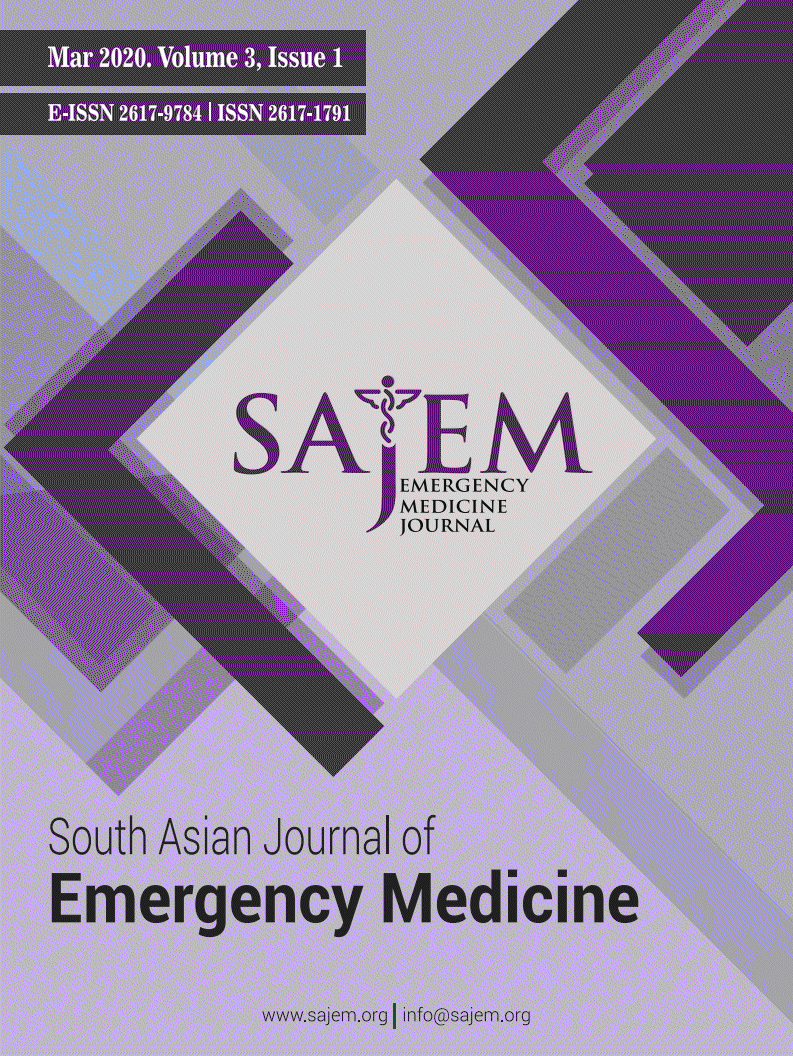
| Original Research Online Published: 11 Apr 2022 | ||
SAJEM. 2021; 4(2): 3-8 doi: 10.5455/sajem.040205 | ||
| How to Cite this Article |
| Pubmed Style Naeem S, Gill T, Fiaz R, Ashraf A, Nasir M. A comparison of accuracy of modified early warning score(MEWS), national early warning score(NEWS)and rapid emergency medicine score(REMS) in predicting length of hospital stay and in-hospital mortality in adults presenting to emergency department. SAJEM. 2021; 4(2): 3-8. doi:10.5455/sajem.040205 Web Style Naeem S, Gill T, Fiaz R, Ashraf A, Nasir M. A comparison of accuracy of modified early warning score(MEWS), national early warning score(NEWS)and rapid emergency medicine score(REMS) in predicting length of hospital stay and in-hospital mortality in adults presenting to emergency department. https://www.sajem.org/?mno=44219 [Access: July 03, 2025]. doi:10.5455/sajem.040205 AMA (American Medical Association) Style Naeem S, Gill T, Fiaz R, Ashraf A, Nasir M. A comparison of accuracy of modified early warning score(MEWS), national early warning score(NEWS)and rapid emergency medicine score(REMS) in predicting length of hospital stay and in-hospital mortality in adults presenting to emergency department. SAJEM. 2021; 4(2): 3-8. doi:10.5455/sajem.040205 Vancouver/ICMJE Style Naeem S, Gill T, Fiaz R, Ashraf A, Nasir M. A comparison of accuracy of modified early warning score(MEWS), national early warning score(NEWS)and rapid emergency medicine score(REMS) in predicting length of hospital stay and in-hospital mortality in adults presenting to emergency department. SAJEM. (2021), [cited July 03, 2025]; 4(2): 3-8. doi:10.5455/sajem.040205 Harvard Style Naeem, S., Gill, . T., Fiaz, . R., Ashraf, . A. & Nasir, . M. (2021) A comparison of accuracy of modified early warning score(MEWS), national early warning score(NEWS)and rapid emergency medicine score(REMS) in predicting length of hospital stay and in-hospital mortality in adults presenting to emergency department. SAJEM, 4 (2), 3-8. doi:10.5455/sajem.040205 Turabian Style Naeem, Salman, Tamoor Gill, Rahma Fiaz, Almas Ashraf, and Muneeba Nasir. 2021. A comparison of accuracy of modified early warning score(MEWS), national early warning score(NEWS)and rapid emergency medicine score(REMS) in predicting length of hospital stay and in-hospital mortality in adults presenting to emergency department. South Asian Journal of Emergency Medicine, 4 (2), 3-8. doi:10.5455/sajem.040205 Chicago Style Naeem, Salman, Tamoor Gill, Rahma Fiaz, Almas Ashraf, and Muneeba Nasir. "A comparison of accuracy of modified early warning score(MEWS), national early warning score(NEWS)and rapid emergency medicine score(REMS) in predicting length of hospital stay and in-hospital mortality in adults presenting to emergency department." South Asian Journal of Emergency Medicine 4 (2021), 3-8. doi:10.5455/sajem.040205 MLA (The Modern Language Association) Style Naeem, Salman, Tamoor Gill, Rahma Fiaz, Almas Ashraf, and Muneeba Nasir. "A comparison of accuracy of modified early warning score(MEWS), national early warning score(NEWS)and rapid emergency medicine score(REMS) in predicting length of hospital stay and in-hospital mortality in adults presenting to emergency department." South Asian Journal of Emergency Medicine 4.2 (2021), 3-8. Print. doi:10.5455/sajem.040205 APA (American Psychological Association) Style Naeem, S., Gill, . T., Fiaz, . R., Ashraf, . A. & Nasir, . M. (2021) A comparison of accuracy of modified early warning score(MEWS), national early warning score(NEWS)and rapid emergency medicine score(REMS) in predicting length of hospital stay and in-hospital mortality in adults presenting to emergency department. South Asian Journal of Emergency Medicine, 4 (2), 3-8. doi:10.5455/sajem.040205 |







